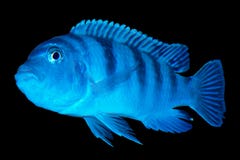

At this point infusoria, and baby brine shrimp should be fed to the fry three times a day. The fry will begin to hatch in a few days, and after about a week, the convict cichlid parents will begin to herd the tiny fry around the tank. The parents will diligently guard the eggs, with the male chasing away anything that comes close to the nest, while the female stays close to the eggs. Once their territory has been staked out, the female will deposit her eggs on a clay pot, and the male will fertilize them. Needless to say, any breeding convicts should be kept in a tank without any other fish present. Any plants will be removed and the substrate will likely be excavated and moved around to their liking.ĭuring this time, the convict cichlid breed pair will viciously attack any other fish in their tank, and few fish – even the armored pleco, can take this abuse for long. Once an egg laying surface has been provided, the male and female will begin clearing the area around their breeding site. Stacks of rocks will also work, and they have also been known to lay eggs in PVC pipe “caves”, but nothing seems to beat the simple clay pots. Since convict cichlids prefer to lay eggs on rocky overhangs in the wild, the easiest way to simulate their natural habitat in the home aquarium is to provide them with overturned clay pots. Unlike many other cichlids, they don’t selectively pair off, and any male and female in placed in an aquarium will usually breed within a matter of weeks. They will especially appreciate any live food that can cultured or caught – with mosquito larvae and live black worms being particular favorites.Ĭonvict cichlids are among the easiest tropical aquarium fish to breed. When it comes to frozen foods, their favorites are blood worms, daphnia and brine shrimp. I prefer to feed my convicts Hikari Cichlid Gold Floating Pellets and have had great success with this high quality food. But a healthy diet should be made up of a high quality fish food, with occasional frozen foods added for treats. In the home aquarium, they will greedily eat nearly anything offered to them. In the wild, convict cichlids primarily feed on small insects, worms, plant matter and algae. You can also read the Aquarium Tidings Aquaclear Filter Review here. If choosing an HOB filter, I would strongly recommend choosing an Aquaclear Power Filter for a convict cichlid tank. This filter combines excellent filtration with a durable design, and it will keep your tank sparkling clear for years to come.

This is especially useful if a person is planning to breed convict cichlids, as the fry need pristine water quality. For extra biological filtration, a second filter or a sponge filter can be added to the tank, which helps keep the water sparkling clean. Since convict cichlids constantly dig and rearrange their tank, their aquarium should be over-filtered with a strong HOB (hang-on-back) filter, or in ideal circumstances, a canister filter. It’s not unusual to see a breeding pair of cichlids take on a much larger fish, and some have been known to attack fish nearly twice their size. A pair of breeding convicts will terrorize any tank that they are housed in, and will viciously attack anything that comes near their nest. If a person is planning to breed convict cichlids, or hopes (and I stress the word hopes) to keep them in a community tank, then they should be kept in at least a 55 gallon (208 litre) fish tank. The minimum tank size for a non-breeding pair should be a 20 gallon (75 litre) tank, though the ideal size is closer to 29 gallons (100 litres). When the females reach breeding maturity, the belly of the fish will take on red hue, making sexing quite easy in mature convict cichlid fish.Ĭonvict cichlids can be a messy fish, and should generally be housed in a spacious, species only tank. The male convict cichlid grows up to 6 inches (15.2 cm) in length, while the female grows to an average length of 4 inches (10.2cm). With that being said, it tends to prefers moving water, and is often found sheltering in submerged branches and rock formations. It is commonly found in streams and rivers, but it is also known to live in ponds and lakes with thick plant cover. The convict cichlid (Amatitlania nigrofasciata) is found throughout Central America, inhabiting a wide array of habitats. Maximum Size: 6 inches (15.2 cm) for males, and 4 for females (10.2 cm) Water Conditions: PH 6-8 and Soft to Neutral Minimum Tank Size: 20 Gallons (29 Gallons recommended)


 0 kommentar(er)
0 kommentar(er)
